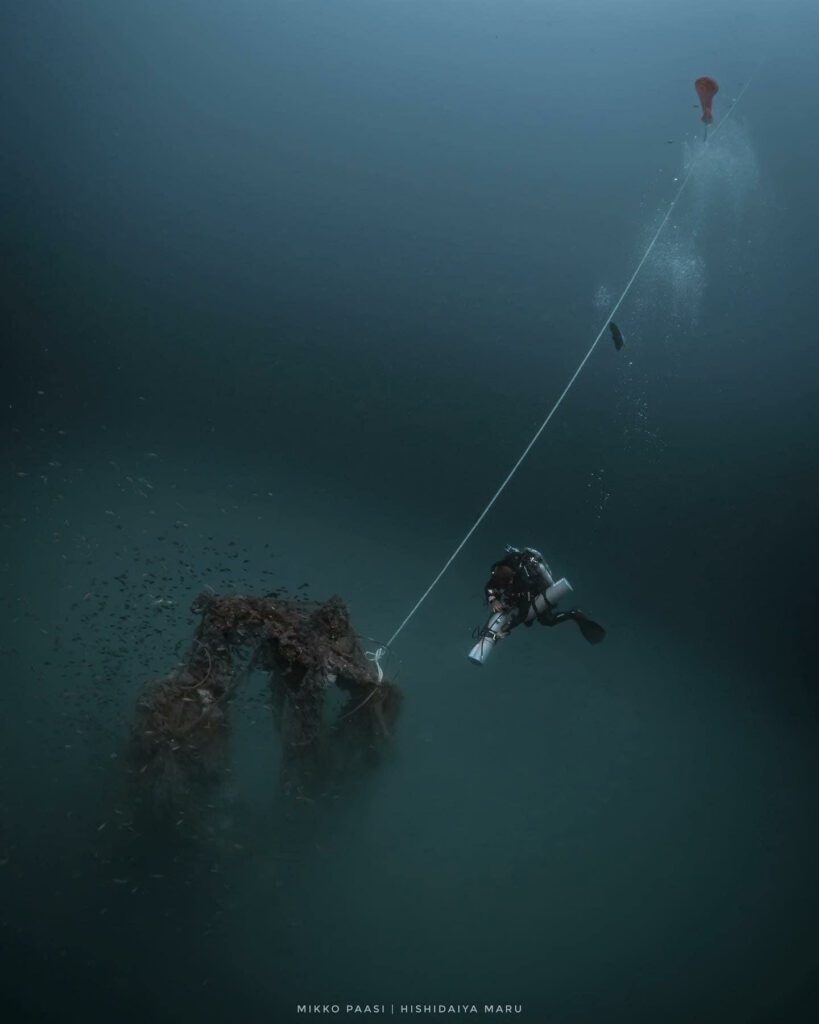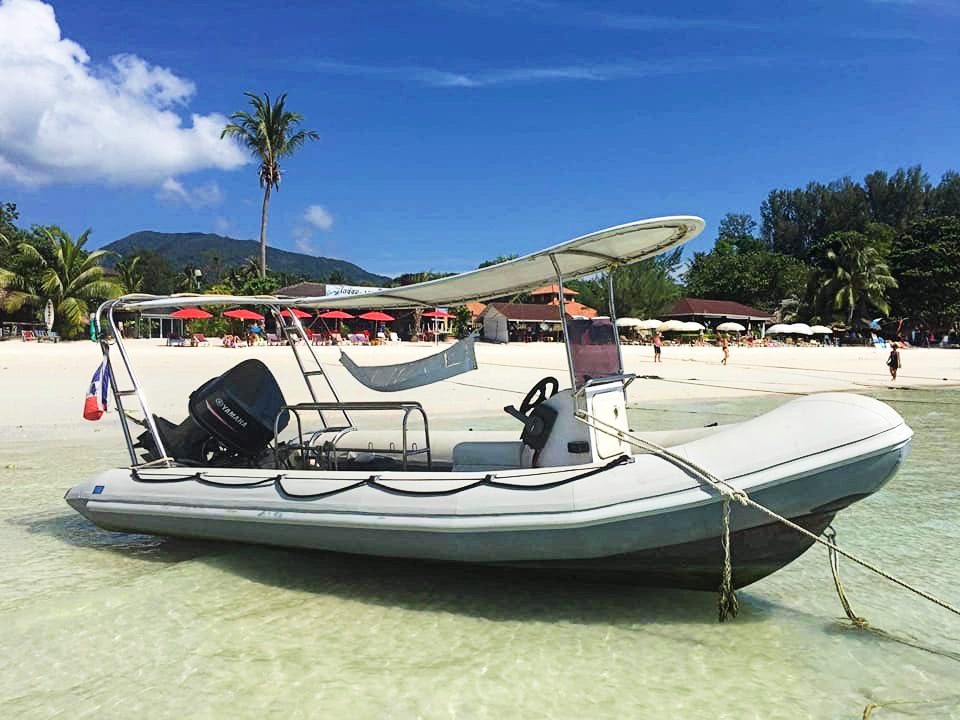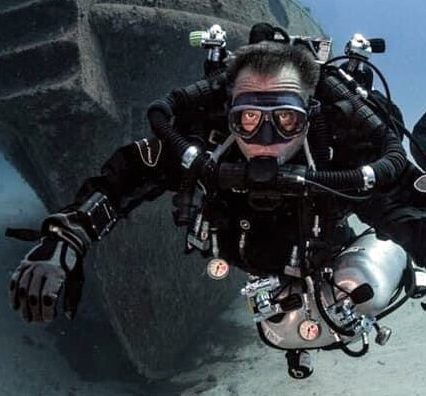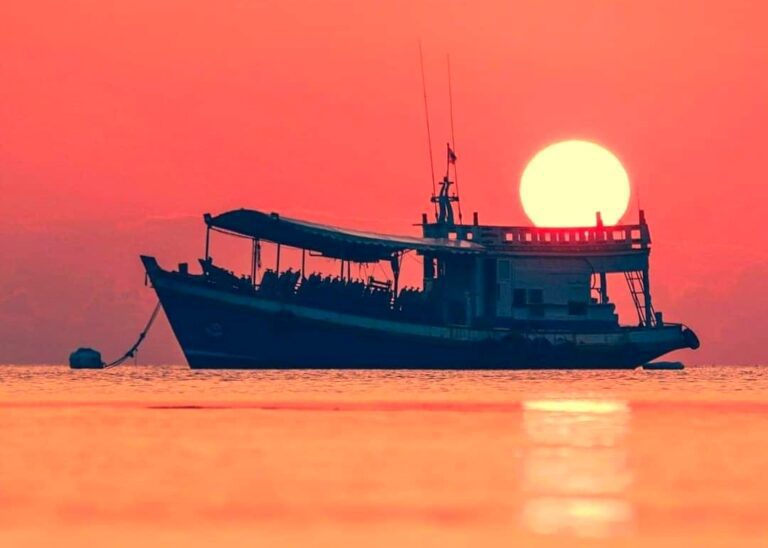Thailand-based technical diver TIM LAWRENCE is well-known as a shipwreck-hunter – but on this occasion it was his own ship that was sinking. Question was, could he and his team save themselves and salvage anything from the situation?
Also read: Wreck-dive obsession: Brothers in arms
As a child, I would listen to my father’s stories of shipwrecked sailors. I remain in awe of the heroic deeds these stricken men delivered as their ships left the surface.
Such stories have entered popular culture, to the point of caricatures such as Uncle Albert in Only Fools And Horses reminiscing about being confronted with the challenges of surviving such a calamity. However, the prospect of such an event happening to me had never entered my mind.
All good stories start with a drink, and this one begins with whiskey. Four tech divers and six fishermen on a chartered dive-boat, we were returning from an expedition to dive HTMS Pangan, a shipwreck located 60 nautical miles north-east of Koh Tao.
The dive-team had completed four technical dives. We were recounting our latest underwater adventures as we returned to Koh Tao and had about 30 nautical miles to go when, suddenly, the boat stopped dead in the water.
Engrossed in conversation with my buddy Gary, I hadn’t really noticed until I felt the captain tug on my arm, gesturing me to join him. Handing Max my half-drunk glass, I followed him below decks, where I found the engine-room full of water!


Now, the definition of a sinking ship is one in which water comes in faster than it goes out. Watching the speed at which the water was rising, I was in no doubt which side of that definition we were on.
We quickly put a third bilge into the water, this one powered by an antique petrol generator, only to find that the generator was not serviceable.
Time was not on our side; the water was rising quickly. I called Gary to strip the twin-sets. Realising that our safety RIB would struggle with weight, I paused momentarily to compare the weight of a fisherman and a compressor! Pushing the thought firmly out of my head, I called Gary to tie down the compressor while I got the RIB ready.
Moving fast, I pulled the rope attached to our chase-boat and, when it was close enough, dived across the gap onto the tubes, rolling across the deck. I found my feet, then trimmed the engines. Turning the key, I held my breath as I waited for the machines to start. One at a time, they purred into life.
Recovering the tow-line, I positioned the RIB as close as I dared. Gary jumped across the gap, and the team passed the light equipment into the boat. Then the crew and dive-team crossed with the captain who was, true to form, the last to leave.
By this time the water was breaching the gunwale. The captain jumped into the sea and splashed his way across. I moved off, and we watched as the ship took its last breath, the air intakes screaming as the water engulfed them.
Then, slowly, it slipped below the surface, white foam replacing the vessel’s outline as it made its way to Davy Jones’ Locker. Fewer than 15 minutes had passed.

As luck would have it, I had the presence of mind to mark the position on my handheld GPS. I then took a minute to take stock of our situation. We were 30 nautical miles out, it was 30 minutes before sunset, we could raise nobody on the radio and we were 10 people on a 5.85m RIB. Also, the wave-height had reached 1.5m.
Unfortunately, our bearing home would take us straight into the teeth of the swell, which was already washing over the tubes. The Gulf of Thailand delivers a nasty high-frequency wave. We needed a plan of action quickly – and a lot of luck.
Lighting a cigarette
Gary had started bailing out some of the water. Nobody would be coming to get us and we would have to make our own way back. We had only 5 litres of fresh water between us, but that would give us little time.
I repositioned the crew around the RIB to get it on an even keel. Max caught my eye, shouting at one of the fishing-crew, who was trying to light a cigarette while sitting on the spare fuel! Max grabbed the lighter and threw it into the sea. Again, wistful thoughts about that compressor raised their ugly head.
I gunned the engines slowly. We got onto the plane, keeping the bow pointed into the trough. I headed for 30° off the east coast, approximately ESE of Koh Tao, attempting to stay on the plane by keeping the RIB positioned in the trough.
I wanted to get into the lee of the island before correcting my bearing towards home. Even so, now and then we were pounded to a stop by a rogue wave. Slowly the sea changed its mood, the high-frequency wave giving way to a gentle roll as the lee of Koh Tao came close enough to grasp.
I took the chance to top off the main fuel-tank with the spare gas stored across the transom. Finally, after what seemed an eternity, we limped into Hin Wan Bay. All our faces showed signs of ageing.
Avoiding the need to contact the boat-owner, I headed straight to our bar, opened a whiskey bottle and dived into the temporary relief that alcohol affords.
Empty bottle
I woke the following day under the bar, with my head in one hand and an empty bottle in the other, our dive-manager wrenching me back to reality with the words: “We need 40 tanks, and we have no compressor!”
Avoiding the next disaster by hiring the tanks from another school, we bought ourselves only a slight reprieve. This expedition was turning out to have been expensive.
I looked for a window in the weather. If our business was to continue, I had to find or replace that compressor.
News travels fast in the close-knit community of divers. Sadly, bad news travels even faster. The next day we had the pleasure of a competitor in our bar, making many uncomplimentary comments. Somehow a diving newsletter had got hold of the story, or a version of it. Unfortunately, this narrative had me cast on a par with Captain Bligh.
Mowing the lawn
The days passed slowly; the bills mounted quickly. Three weeks passed and, finally, we got a three-day weather window. Then, with all the pre-pumped tanks we could muster, we set off again in search of the sunken dive-boat and, more importantly, our compressor.
Travelling overnight, we arrived at the site at 6am and began “mowing the lawn” (sweeping a search with our sounder). Wooden boats with light displacement don’t sink straight, but tend to drift with the currents.
We guessed that the windward drift would have pushed the sinking ship towards the north-east, so our search swept in that direction from the mark I had taken on that fateful night.
After an hour of searching, we had a return. I jumped into the sea looking to reap the reward but, to my dismay, only sand welcomed me at 60m.
Undeterred, we ran the deco and got back in the game. Seven hours would pass before the next return, and a significant mark appeared on the screen. It was clearly a shipwreck, 12 nautical miles from where our vessel had left the surface three weeks before – so was it ours?
Seven hours into our search, time was disappearing quickly. It was 2.30pm when we left the surface for the second time that day. Vis was good at 10m and suddenly coming into view was the bow of the stricken dive-boat. My heart jumped a beat – we had found it.
Working quickly, I tied our shotline into the Bimini. I then took a second thin line through to the compressor, and checked the line for straightforward access to the surface before attaching it.
Cutting the ties securing the compressor to the ship, we returned to the ascent-line, grabbing twin-sets and connecting them to the bottom of the shotline. We started our ascent.
Gary’s team was next up. Their job was to secure the lift-bags, ensure that the lift was free and blow the compressor to the surface. They did this brilliantly.
We pulled the safety-line into our boat, bringing the compressor alongside. Four of us struggled to lift it onto the deck. With sunset approaching fast, I hurried to get back in for my last dive.
On the bottom, we made our final sweep of the wreckage, looking for valuables and then pausing to take the compass from the bridge. We moved our last twin-sets to the ascent-line, securing them for retrieval with the shot. I untied from the wreck, and we headed for the surface.

Unlikely recovery
I was amazed at how lucky we had been. We had pulled off an unlikely recovery, all through the fog of a 60m narcosis. The compressor had pressure internally, meaning that no water had entered. We changed the power unit and filters, washed it down, fired it up and, mercifully, the compressor pumped flawlessly. It’s still in use today (albeit having had three new pistons and two crankshafts!).
I pondered the possibility of the compressor manufacturer (it was a Coltri MCH 16) being interested in the story. Our team had manufactured a silk purse out of a pig’s ear with a generous helping of luck. Finally, we had recovered our dignity – well, some of it. With my thanks to the rest of the dive-team that day – no finer group could I wish for.

TIM LAWRENCE owns Davy Jones’ Locker (DJL), based on Koh Tao in the Gulf of Thailand, a centre that offers divers the chance to further their skills beyond the range of recreational scuba diving, and runs the SEA Explorers Club. A renowned technical wreck and cave explorer, and a member of the Explorers Club New York, he is a PADI / DSAT Technical Instructor Trainer. (Photo: Mikko Paasi)
Also on Divernet: The Ship’s Bell

